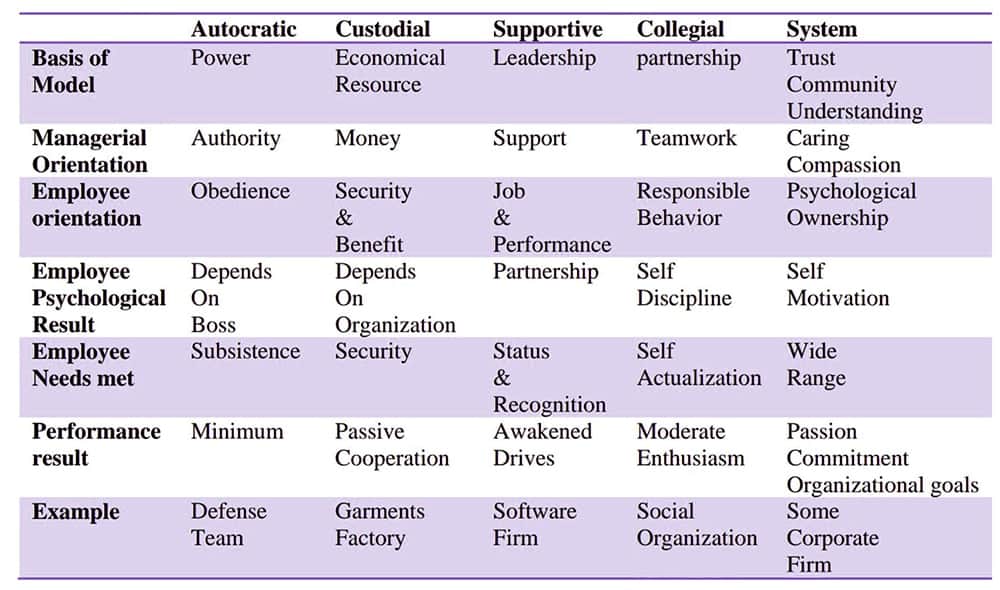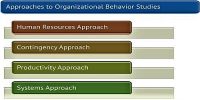There are five model of organizational behavior, such as-
1. Autocratic Model
The basis of this model is the power of the boss. The essential features of this model are as follows:
- The organization with an autocratic environment is authority oriented. This authority is delegated by the right of command over the people to whom it applies. The management believes that it is the best judge to determine what is better for the health of both the organization and its participants and that the employees’ obligation is to follow orders. It assumes that the employees have to be directed, persuaded and pushed into performance. Management does the thinking and employees obey the orders. This view of managing organizations has been developed by D. McGregor in his theory X. This conventional view leads to tight control of employees at work.
- Under the autocratic model, the employee’s orientation is obedience to the boss; they need not be respectful to him. The bosses have absolute power to hire fire and perspire employees. The employees depend on the boss and are paid minimum wages for minimum performance. This theory of scientific management was developed by F.W. Taylor as the conventional view of management. The employees sometimes give the minimum performance, though reluctantly because they have to satisfy the subsistence needs of themselves and their families. Some employees give higher performance because of a drive to overcome challenges. According to the research of David C. McClelland of Harvard University, “some people like to work under strong authority because they feel that their boss is a natural born leader.”
- The autocratic model has been successful in some situations where the workers are actually lazy and have a tendency to shirk work. It is also required in the situation. Where the work to be done is time bound. The threat generally used by the managers is that the reward or wages will be withheld if the workers do not obey them.
- The leadership in an autocratic model is negative because the employees are uninformed, insecure and afraid.
- Nowadays, this model is not applicable in the strict sense because there are minimum wages laws in most of the countries. Thus, the managers cannot threaten to cut down the wages or rewards of the workers. Moreover, the workers are educated and organized, thus they cannot be dictated to by the managers all the time.
2. Custodial Model
To overcome the shortcomings of the Autocratic model, the custodial model came into existence. The insecurity and frustration felt by the workers under the autocratic model sometimes led to aggression towards the boss and their families. To dispel this feeling of insecurity and frustration, the need was felt to develop a model which will improve the employer-employee relations. The custodial model was used by the progressive managers.
Some of the important features of this model are as explained below:
- The success of the Custodial Model depends upon the economic resources because this model emphasizes the economic rewards and benefits. Since employee’s physiological needs are already met the employer looks to security needs as a motivating force.
- The employees under Custodial Model depend upon organization rather than their boss. If the organization has got good welfare and development programmers for the employees, they cannot afford to leave the organization.
- Under this model, the employees are satisfied and happy and they are not strongly motivated. So they give only passive cooperation. They do not work more vigorously than under the autocratic approach.
- The main benefit of this model is that it brings security and satisfaction to the employees.
- The difficulty, with this model, is that it depends upon material rewards only to motivate the employees. But the workers have their psychological needs also. Due to the drawbacks of this method, a search began to find out the best way to motivate the workers so that they produce to their full capacity and capabilities.
3. Supportive Model
The supportive model has originated from the ‘Principles of Supportive Relationships.” The main features of this model are as follows:
- The Supportive Model depends on leadership instead of power or money. Management, with the help of leadership, try to create a favorable organizational climate in which the employees are helped to grow to the greater capacities and achieve things of which they have the capability, in compliance with the goals of the organization.
- The leader assumes that the worker will take responsibility, nuke their contributions and improve then ekes, given a chance. It is assumed that the workers are not Lazy and work shirkers by nature. If properly motivated, they can be self-directed creative to the organization,
- It should be the orientation of the management to support the concrete performance, rather than simply giving them pay-merits and benefits as in the Antolini approach.
- This model takes care of the psychological needs of the employees in addition to their subsistence and security needs. It is similar to McGregor’s theory and the human resources approach to people,
- This model is an improvement over the earlier two models Supportive.behaviour helps in creating friendly superior-subordinate interaction with a high degree of confidence and trust. This model has been found to be effective in affluent countries where the workers are more concerned about their psychological needs like high self-esteem, job satisfaction etc. But it has limited application in India, where the majority of the workers are below the poverty line. For them. the most important requirement is the satisfaction of their physiological needs and security. They are not much concerned about the psychological needs.
4. Collegial Model
The collegial model is an extension of the supportive model. The Dictionary meaning of collegial is a body of persons having a common purpose. As is clear from the meaning. this model is based- upon the partnership between employees and the management.
The features of this model are as follows:
- This model creates a favorable climate in the organization as the workers feel that they are the partners in the organization. They don’t see the managers as their bosses but as joint contributors. Both the management and workers accept and respect each
- The collegial model inculcates the team spirit in an organization.The workers accept responsibilities because they find it their obligation to do so, not because that they will be punished by the management. This helps in developing as tern of self-discipline in the organization.
- In this kind of collegial environment, the workers have job satisfaction, job involvement, job commitment and some degree of fulfillment.
- The collegial model is especially useful in research laboratories and similar work
5. System Model
An emerging model of organizational behavior is the system model. It is the result of a strong search for higher meaning at work by many of today employees. They want more than a paycheck and job security from their job. In this model helps for the gowning sense of community among co-worker. Under the system, model manager tries to convey to each other that you are an important part of your whole system. We sincerely care about of you. We want to join together to achieve a better product or service local community of the employee. Trust in the employee psychology operative explain the best model of the organizational model.
Overview














